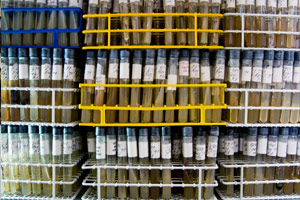Specimen Collection
Harbor Branch Specimen Collection

The Marine Biomedical & Biotechnology Research Program has an extensive collection of marine organisms to support its research. Many of these specimens were collected using the historic Johnson-Sea-Link I and II submersibles, which featured unique capabilities for collecting fragile specimens from the ocean floor and sites not accessible with trawls or dredges, such as deep fore reefs, vertical walls and boulder zones. The group also collects specimens by scuba, snorkeling and wading. The majority of samples comes primarily from around the Atlantic and Caribbean; others have come from the Galapagos, western Pacific, Mediterranean, Indo-Pacific, Western Africa and the Bering Sea.
Invertebrates
The collection includes an extensive array of frozen invertebrates that are used for marine natural products drug discovery research. The wide diversity of marine habitats that have been sampled includes deep continental and island slopes, deep and shallow reefs, coral banks and walls, rhodolith banks, caves, grass beds, oyster and mussel beds, kelp forests, mangrove lagoons, inland salt lakes, shipwrecks, and pilings and jetties.
Two strategies have been used in collecting specimens for drug discovery research. The first is to maximize taxonomic diversity. In this process, an emphasis is placed on collecting specimens which are related, but different, from those which are known to have bioactive natural products. The second emphasis is to evaluate ecological factors such as consumer pressure, growth form (e.g., thin encrusting vs. massive), level of resource competition and presence or absence of biofouling, and relate this to expression of secondary metabolism. For instance, we have observed a higher percentage of cytotoxic active agents in thin encrusting sponges. One possible role for these compounds may be to allow for continued colonization of relatively large surface areas.
We have also observed a greater percentage of active compounds in invertebrate consortia (e.g., where two invertebrates grow in association). For example, the sponges Spongosorites sp. and Thrombus sp. are in almost all instances found in association with Vermetid molluscs and both possess potent bioactive compounds. Interestingly, we have also observed that organisms which are conspicuously colored and live in habitats with limited or no ambient light often possess interesting secondary metabolites (Dercitus sp. and Spongosorites sp.). Such organisms are also targeted for collection.
Microbes
As a part of our drug discovery efforts, the microbiology group has developed a major culture collection of marine microbes (the Harbor Branch Marine Microbial Culture Collection, HBMMCC) derived in large part from deep-water sponges. The collection consists of more than 19,000 microorganisms, with 11,000 from depths greater than 45 meters.
A total of 2,290 heterotrophic bacterial isolates have been identified. This subset contains 233 different taxa from six major bacterial clades (Alpha-, Beta-, and Gamma-Proteobacteria), CFB (Cytophaga, Flavobacteria, and Bacteroides), Gram+ High GC Content, and Gram+ Low GC Content.
The HBMMCC also holds more than 1,600 fungal isolates. The majority (1,250) of these isolates was derived from marine invertebrates with the remainder isolated from environmental samples such as wood and water samples.
The development of this culture collection demonstrates the rich diversity of cultivable microorganisms that is present in the marine environment. Cultures are added to the collection at a rate of 250-500 per year.
The Harbor Branch Marine Microbial Database contains information on the subset of the collection that has been identified using molecular techniques.
Isolates are grown in liquid culture (fermentation) and extracted to provide material for the drug discovery program. Isolates are also tested for their activities in biotechnological applications.
